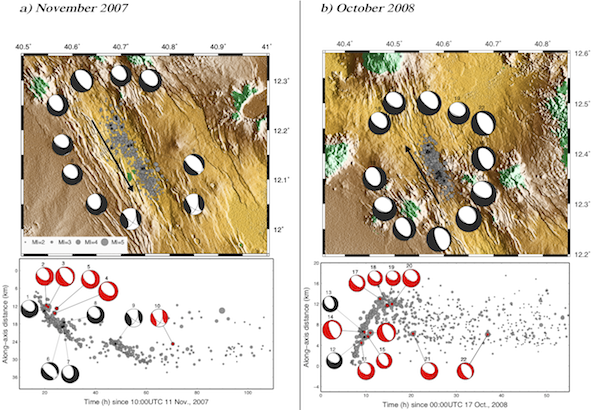2012 IRIS Workshop
Dynamics of Dike Intrusions and 3D Velocity Structure beneath an Incipient Seafloor Spreading Center in Afar, Ethiopia
Manahloh Belachew: University of Rochester, Cindy Ebinger: University of Rochester, Dustin Cote: University of Rochester
(a) (Top) Plot of epicenters and source mechanisms for earthquakes generated during the November 2007 dike intrusion. Arrow shows the propagation direction of the dikes. (Bottom) Space-time distribution of the source mechanisms in relation to the along-axis southward migration of epicenters (modified from Belachew et al., 2011). The mechanisms with red compression zone represent the low-frequency earthquakes that have peak frequencies of Čš_ 2 Hz. (b) Same as in (a) but for October 2008 dike which propagated northwards.

Full-resolution graphics file in original format: 0100.ps
A rifting episode started in September 2005 with an intrusion of a 60 km-long mega-dike along the Dabbahu-Manda Hararo (DMH) rift segment in Afar, Ethiopia. Between 2005 and 2009 thirteen smaller volume dikes intruded different portions of the rift segment. Out of the 13 dikes, 9 were recorded on a temporary network of 44 three-component broadband stations. The dynamics of the dike intrusions are studied using the detailed analysis of the spatial and temporal distribution of dike-induced earthquakes and their source mechanisms. In addition, a 3D model of seismic velocity structure is determined using local earthquake travel time tomography algorithm. The dike-induced migration patterns of the earthquakes show the dikes were fed from a ~5 km-radius zone at the middle of the DMH segment, and traveled northward and southward along the rift axis. The dikes that propagated north of the mid-segment have higher propagation rates and short migration duration relative to the dikes that propagated south. Faulting and graben formation above the dikes occurs hours after the passage of the dike tip, coincident with the onset of low-frequency earthquakes, and accounts for the large percentage of seismic energy release during an intrusion. The large deficit between total seismic and geodetic moment estimates, and the similarity between total seismic slip and geodetic slip estimates on normal faults above the dikes indicates that dike inflation and most of plate boundary deformation occurs largely “aseismically”. Local earthquake travel time tomography reveals low velocity zones at depths >13 km beneath the Dabbahu volcanic complex, and a broad zone of low velocity beneath the mid-segment. However, the lack of migrating seismicity originating from the Dabbahu volcano suggest that only the magma source zone beneath the Ado’Ale Volcanic Complex is actively feeding the dikes. The DMH rift segment is at the magmatic stage of the tectono-magmatic cycle proposed for slow spreading
For further reading: Belachew, M., C. Ebinger, D. Cote, Source mechanisms of dike-induced earthquakes in the Dabbahu-Manda Hararo rift segment in Afar, Ethiopia, Geophys. J. Int., in review. Belachew, M., C. Ebinger, D. Cote, D. Keir, J. V. Rowland, J. O. S. Hammond, and A. Ayele (2011), Comparison of dike intrusions in an incipient seafloor-spreading segment in Afar, Ethiopia: Seismicity perspectives, J. Geophys. Res., 116, B06405, doi:10.1029/2010JB007908. Ebinger, C.J., A. Ayele, D. Keir, J. Rowland, G. Yirgu, T. Wright, M. Belachew, and I. Hamling (2010), Length and time scales of rift faulting and magma intrusion: The Afar rifting cycle from 2005 to present, Annu. Rev. Earth Planet. Sci. 2010. 38:437-64. doi: 10.1029/2010JB007908
Keywords: dike_intrusions, seismicity, seafloor_spreading, afar, ethiopia
